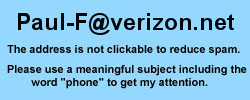|
|
|
|
|
|
|
TOPICS
ON THIS PAGE:
Production Card Dialers Modified Card Dialers Cards Coding Cards RELATED PAGES ON THIS SITE: WE 660-SERIES WE 1660-SERIES WE 2660-SERIES WE AUTOVON Dialer Data Phone Card Readers |
| Western Electric 660-type
Rotary Bar split:
Release
and Start For model variations, click here. |
|
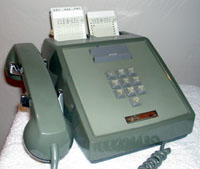 Photo
of a set in the JKL Museum
|
Western
Electric
1660-type Touch Tone, 10 button dial Single Bar: Start For model variations, click here. |
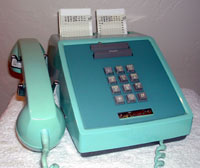 Photo of a set in the JKL Museum |
Western
Electric
2660-type Touch Tone, 12 button dial Single Bar: Start For model variations, click here. |
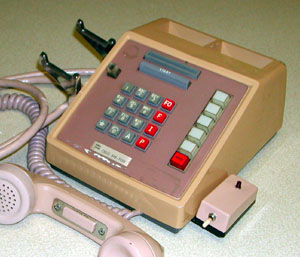 Photo
from
Wayne Merit
|
Western Electric 3660-type Touch Tone, 16 button dial for Autovon Single Bar: Start For details, click here. |
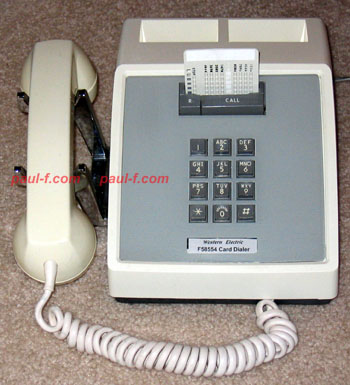 Photo from David Friedman |
Western Electric F-58554-type Uses F-58553 dial and modified cards - to "provide extended life in high usage applications." Bar split: R (= Reject) and Call For details, click here. |
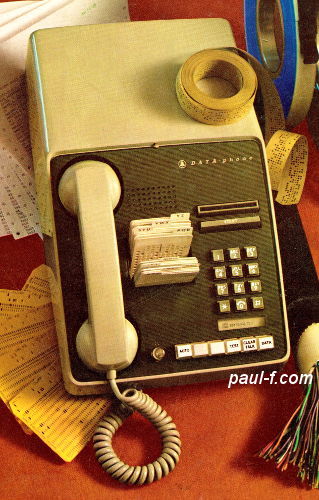 |
Western Electric Dataphone 103G4 Data Set with Touch-tone Card Reader Also available in rotary (104G3) More info, click here. |
| Modified
Card
Dialers |
|
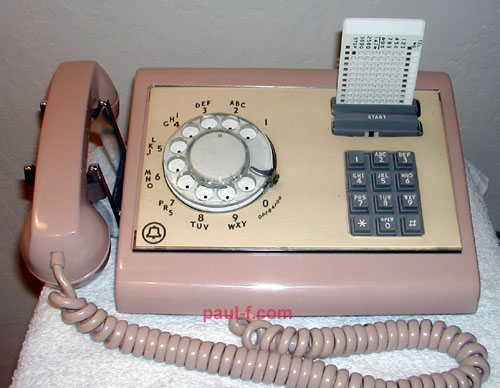 |
Rotary - Touch Tone Card
Dialer Includes a rotary telephone and Touch Tone Card Dialer in one integrated telephone. Modified in the Western Electric Distribution Houses. Marked 630DAM, 1179NO, 659523, Property of So. Central Bell. G3 handset. 630DAM is the model of the donor Call Director set. 1179NO is the date, 11/79 and code for New Orleans. 65923 is the standard modification code number. Another found set is marked SET TEL, DIG TRANS, B659523, MODIF, and has a G5 handset with fatter 6-conductor handset cord. The rotary dial could be used to dial a computerized service thru a non-Touch Tone Central Office. Then Touch Tone data was entered using either cards or the keypad. |
Multi-line Rotary and Touch Tone Card Dialer with Speakerphone |
|
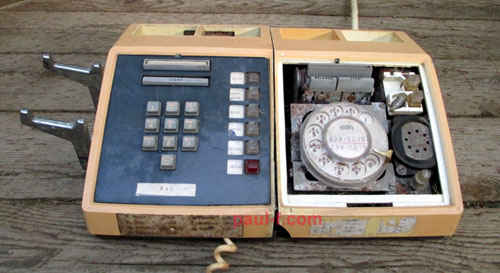 1662 Touch Tone Card Dialer 661A Rotary Card Dialer |
"Siamese
Twins" Card Dialers Appears to be two complete modified Card Dialers joined at the hip and sharing one mounting cord and handset. They are wired together to operate as one integrated telephone. Modifications to the 1662 (left) include cutting away the right side of the case and the installation of the speaker in the wells behind the dial, and pointing out the back of the unit. Modifications to the 661A (right) include cutting away the left side of the case and replacing of the line key with a standard speakerphone module. |
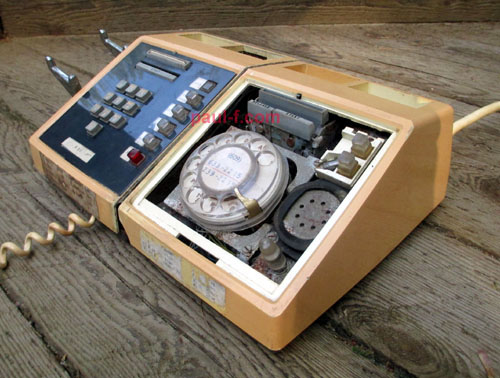 |
History and Operation This set was found in the barn of a retired Western Electric engineer. He believed it was cobbled together as an experiment to see how the combination would work in several applications such as remote ordering or banking -- areas his group had studied for many years. The labels on the front edge with names and extension numbers suggest the set was actually placed in service -- at least as a test. Some earlier Dataphone items were found in the same storage area. They were also used in similar applications, with card readers used to enter product model numbers and quantities for manufacturing and ordering applications and account numbers for banking. For some of the earlier Western Electric experimental card readers, go here: Data Phone Card Readers The rotary dial was needed to dial the access number, as many exchanges weren't Touch Tone in those days. Once on-line, some data could be manually entered using the Touch Tone keypad. |
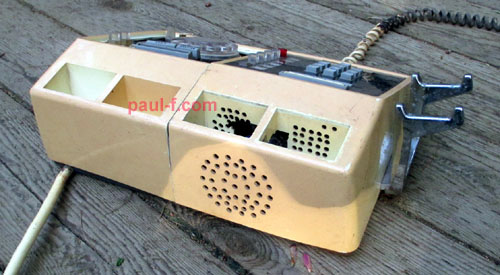 |
The
crude
work cutting and matching the cases, uneven drilling of
the holes on
the back, and the placement of the speaker suggest it was
made for a
"quick and dirty" feasibility study. There are no
test markings,
as was common for more formal field trials. The pattern of the color fading strongly suggests that the rotary faceplate was in place for years, then was lost or broken and discarded. It would be interesting to see what it looked like. We may never know for sure. Unfortunately the white set was quite sun-faded, then stored in a wet location. The bottom is quite corroded and the internals are probably useless. The set was covered with a nice protective layer of dirt and mold. Some can still be seen on the handset cord, which hasn't had the first pass cleaning treatment yet. I'll post more photos including the inside as the restoration continues. |
| Cards for Automatic Dialers | |
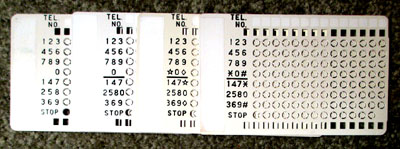 Cards measure approximately 3 7/16" x 2 7/32" x 1/32" All use a 2 of 8 code: 2 punches in a column for each digit. For instructions, see Coding Cards below. Once punched, the card is a read-only storage device. |
Cards for rotary and
standard Touch Tone dialers Cards are physically identical but are marked for different dials: 1. Early Rotary sets (digits 1-0 only) Box of 20: P13E353 2. Later Rotary or 10-button tone sets (0 added on 258 row) Box of 20: P24E238, 812 452 381 3. 12-button tone sets with star and diamond keys. Box of 20: P28E382 4. 12-button tone sets with * and # keys Box of 20: P21F752, 812 167 526 |
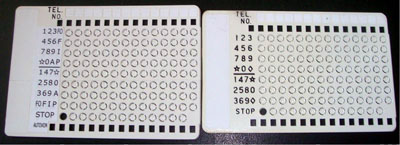 |
Card for Autovon sets Shown left of a standard early Touch Tone card. Looks like standard cards, but is wider to accommodate an additional row of holes to code the fourth column of buttons: FO, F, I and P. Box of 20 cards: P-29E718 Card Index set: P-29E719 |
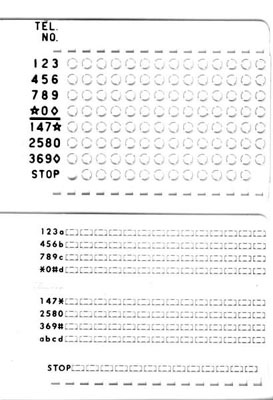 |
Card for F-58553 dial Shown below a standard early Touch Tone card. Only one row of sprocket holes and rectangular (not circular) holes. Cards meet American National Standards Institute standards and are not interchangeable with cards used with earlier model card dialers. Programmable for digits 0-9, *, #, a, b, c and d for use in special applications such as banking or inventory control. The F-58553 dial is used in the F-58554 set, F-58555 keyset and 1037B dial adjunct (F-58556) Box of 20: 840 360 564 |
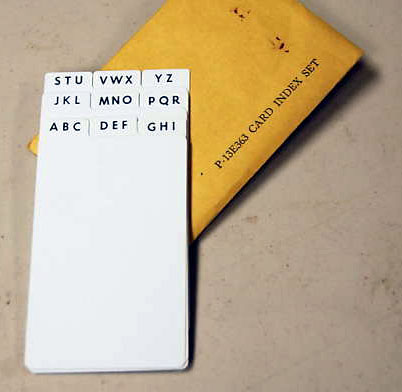 |
Card Index Set Used to alphabetize cards stored in the wells behind the dial. Set order codes: P-13E363, 811 353 630 |
